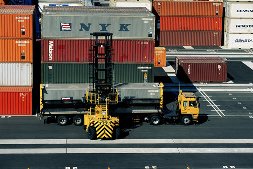
Integrated into its proven and widely used platform of LVS, the Container Terminal Vision (CV) is a sophisticated information system that manages and optimizes the processes and resourses of a container terminal such as the container, container handling equipment, trucks and human resources.
In addition to that, LVS is also offering a fully integrated Gate Management System (GMS) that complements and enhances the functionality of CV, providing a total solution that cater to the needs of a modern container terminal.
Mantis' CV and GMS allow companies running container terminals to improve their competitiveness by reducing their operational costs while simultaneously increasing their customer service level.
The advantage of Mantis' solution is that a single platform (LVS) supports all operations of a port &/or train hub including among else Container Terminal, CFS, General Cargo & Bulk Hub, Car & Ro/Ro Terminal, Industrial & Free Zone area and 3rd Party Logistics, thus turning a port into a sophisticated multipurpose port and logistics center.
Container Terminal Vision (CV) manages and optimizes the space of the container yard as well asthe container inbound and outbound processes. During inbound (from vessel, train or truck), CV selects the location to store the container based on a number of user defined criteria. It then guides (through RF) the proper personnel/eqiupment to move and store it at the right location. In outbound, CV identifies the right container and guides (through RF) the proper personnel and equipment to pick and move it.
Wireless Radio Frequency (RF) terminals and networks of special design are used to enable CV to collect data and guide container handling equipment, trucks and personnel in real time.
Gate Management System
Gate Managment System (GMS) manages and automates the gate procedures of container terminals. GMS includes enhanced security gradings as harbours and free trade zones. It comprehensively covers all control, follow up and recording procedures for anything it enters or it comes out from such areas, as means of cargo transport (trucks, vessels and trains), supply vehicles, private vehicles, personnel, visitors, maintenance workshops etc., encompassing all safety, human resources, technical (Cameras, Smart card systems, Traffic Lights, sensors, etc.) in one system.
The main goal of GMS is to record all passages in and out from the free zone that will be done by road transport (vehicles), rail transport (trains) and by floating crafts (vessels/barges). Every object moving inward or outward of the free zone is recorded separately in the system with the maximum detail of information required. Additionally, information for billing purposes is also recorded concerning movements of any object and services provided to the companies established in the free zone's industrial area, as well as to vehicles, trains, and vessels, cargo transport movements and finally information for security issues.
Container Freight Station
Container Freight Station (CFS) module is supported by LVS' sophisticated logistics functions that not only enable the automation of typical CFS operations but also extend CFS to provide full 3rd party logistics services.
Container Terminal Billing
A modern container terminal is offering a rich portfolio of services that requires a sophisticated billing system. Container Terminal Billing (CTB) module generates the detailed billing reports and relevant invoices concerning all activities of a container terminal.
Visual Container Terminal Manager
This module is a state-of-the-art tool that allows the visual monitoring in real time of the location, status and movements of containers through the yard.
Workforce Supervisor
It is visual user-friendly tool that enables container terminal managers to monitor the actions of their personnel (RF users) and interact with them in real time. Besides monitoring, expert managers can use this tool to remotely help/train their personnel in real time.
Web Track & Trace
It enables properly authorized container operators (eg. MSC), to remotely (via a web browser) access the terminal and monitor in real time the status of their contaners.
 Integrated into its proven and widely used platform of LVS, the Container Terminal Vision (CV) is a sophisticated information system that manages and optimizes the processes and resourses of a container terminal such as the container, container handling equipment, trucks and human resources.
Integrated into its proven and widely used platform of LVS, the Container Terminal Vision (CV) is a sophisticated information system that manages and optimizes the processes and resourses of a container terminal such as the container, container handling equipment, trucks and human resources.